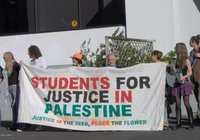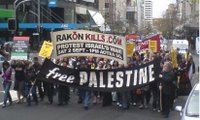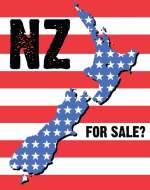 We really are everywhere
We really are everywhereBy Omar Hamed
"It is from numberless diverse acts of courage and belief that human history is shaped. Each time a human stands up for an ideal, or acts to improve the lot of others, or strikes out against injustice, they send forth a tiny ripple of hope, and crossing each other from a million different centres of energy and daring, those ripples build a current that can sweep down the mightiest walls of oppression and resistance." - Robert F. Kennedy
Out here in the middle of the south Pacific, thousands of miles from the daily bombings, shootings, demolitions and harassment that occurs in the occupied territories it can sometimes seem like what we do in this small corner of the world will have no impact on stopping the Israeli apartheid. The reality is very different however. Across the globe people have been coming together and resisting this injustice. These people seek out one another, smashing down walls that separate people and meeting more people and breaking down bigger, stronger, more oppressive walls. The struggle for liberation in Palestine is a global one and those who walk with the Palestinians are everywhere.
In 2003 a group of students at a university near Washington, D.C. hosted what they called a "Week of Awareness for Refugees of Palestine." Events during the week, held at the University of Maryland campus, included an art exhibition, music concerts and a film festival. The centrepiece of the week was a Palestinian refugee camp constructed in a high traffic area in the middle of the campus. "Basically we have four huts constructed of wood, and the four huts are about 4 feet [1 meter] deep and eight feet [2.5 meters] tall," said Sami Meaddi, 18, a freshman at the school who has spent a lot of time at the refugee camp. "It pretty much simulates what refugee camps are like. Some of them leak, and they are very cold at night." The university supported the construction of the camp, which was surrounded with information displays, articles and lists statistics about Palestinian refugee camps and included a huge wall, nine meters long and 2.5 meters high.
Last year SJP at DePaul University in the US organised a hip-hop lyrics for liberty concert with all proceeds going to the Palestine Children’s Relief Fund.
On May 15th in 2002 a small group of protesters from Jews For a Free Palestine protested against the Jewish Community Federation meeting inside by unfurling inside the conference a banner protesting aid to Israel and linked arms. Police arrived and the protesters were taken away.
At Berkley University in 2002 the University suspended SJP, after hundreds of students occupied a building and demanded a meeting with the school chancellor to force the Uni to stop investing in and supporting Israel. Police dragged protesters out of the building and over 79 people were arrested. The group was suspended for “disrupting classes”, disruption that included Palestinian children's art, so people could see what the kids there are drawing, what's on their minds and a big white roll of butcher paper that went from the plaza all the way down the street, with the names of all the villages destroyed in 1948 in the founding of Israel. Some students put on kaffiyehs, bound our hands, and were blindfolded, and had a grocery bag with clothes. People walking by said `who are these people?' They were representing people who were told by the IDF to grab a few things before they destroyed their homes and detained them. One science Professor even told his “disrupted” class to go out and join the protestors.
In 2005 a group of sixty prominent British architects and planners threatened to boycott the Israeli construction industry over the erection of the Occupation Wall and practices in the occupied territories. Following a meeting hosted by the architects behind the Millennium Dome, Architects and Planners for Justice in Palestine announced its plan. The group called for an economic boycott of Israeli construction industries in protest of the building of the settlements and the separation wall in the Occupied Palestinians Territories.
At the same time the Church of England's overwhelming vote in favour of divesting its £2.2 million shares from bulldozer manufacturer Caterpillar. The vote, supported by the Archbishop of Canterbury, Dr Rowan Williams, sends a clear message to Caterpillar that profiting from human rights violations is not compatible with socially responsible business practice.
Keeping with the good news, seven activists who blockaded the British distribution centre of Israel’s biggest state-owned agricultural export company Agrexco in November 2004 with chicken wire fences and bicycle D-Locks were acquitted of all charges on January 26. The activists had been charged with aggravated trespass. According to Agrexco, it lost £100,000 as a result of the eight-hour blockade. The international campaign to boycott Israeli goods is growing across Europe. In December 2005 a whole region of Norway voted to cut economic relations with Israel. One of the more bizarre acts of resistance to Zionism must be from the San Francisco group Queers Undermining Israeli Terrorism (QUIT) which “settled” a downtown Starbucks in a protest against Starbucks founder and CEO, Howard Shultz, a major supporter of the Israeli state. “Since Mr. Shultz clearly believes it is okay for one group of people to grab land belonging to another and say they have a right to it, we figure he won’t mind if we take some of his,” a QUIT leaflet explained.
In Auckland when we blockaded Oscmar, a weapons training manufacturer that exports to Israel we caused economic damage by emptying the offices for three afternoons in a row. All those on the blockade knew we were not alone; from San Francisco to Sweden resistance is fertile. We who today are ripples of resistance will tomorrow be the tidal wave that knocks down the walls of oppression and injustice. The question is-will you be a ripple or a wall?
Published in
Intifada September 2006
Labels: palestine
 Many Peoples, One Struggle
Many Peoples, One Struggle




